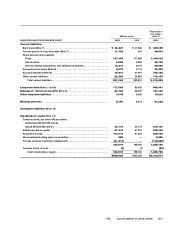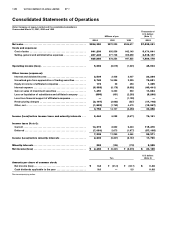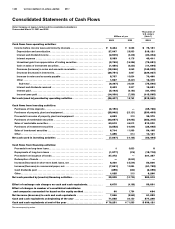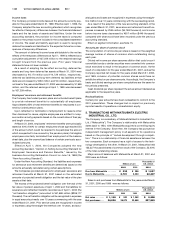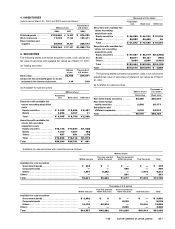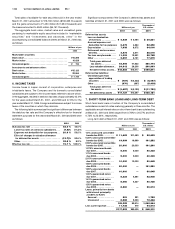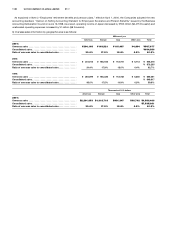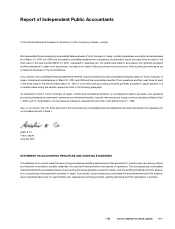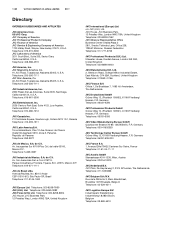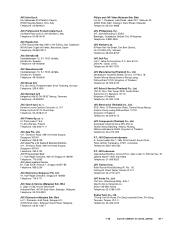JVC 2001 Annual Report Download - page 37
Download and view the complete annual report
Please find page 37 of the 2001 JVC annual report below. You can navigate through the pages in the report by either clicking on the pages listed below, or by using the keyword search tool below to find specific information within the annual report.
The 1.5% unsecured convertible bonds are redeemable prior to
their stated maturity, in whole or in part, at the option of the Com-
pany at prices ranging from 107% to 100% of the principal amount,
respectively. The price at which shares of common stock shall be
issued upon conversion is ¥2,867 ($23.12) per share, subject to
adjustment under certain circumstances. The 0.35% and 0.55%
unsecured convertible bonds are redeemable prior to their stated
maturity, in whole or in part, at the option of the Company at prices
ranging from 102% to 100% and 103% to 100% of the principal
amount, respectively. For both issues, the price at which shares of
common stock shall be issued upon conversion is ¥1,487 ($11.99)
per share, subject to adjustment under certain circumstances.
The aggregate annual maturities of long-term debt at March 31,
2001 were as follows:
Thousands of
Year ending March 31 Millions of yen U.S. dollars
2002 . . . . . . . . . . . . . . . . . . . . . . . . . . . . ¥11,732 $ 94,613
2003 . . . . . . . . . . . . . . . . . . . . . . . . . . . . 27,050 218,145
2004 . . . . . . . . . . . . . . . . . . . . . . . . . . . . 7,334 59,145
2005 . . . . . . . . . . . . . . . . . . . . . . . . . . . . 13,052 105,258
2006 . . . . . . . . . . . . . . . . . . . . . . . . . . . . 39,863 321,476
Thereafter . . . . . . . . . . . . . . . . . . . . . . . 30,294 244,307
¥129,325 $1,042,944
8. PLEDGED ASSETS
The following assets were pledged as collateral for current portion of
long-term debt and accrued expenses at March 31, 2001:
Thousands of
Millions of yen U.S. dollars
Investments . . . . . . . . . . . . . . . . . . . . . . ¥ 1$8
Machinery and equipment . . . . . . . . . . 110 887
¥111 $895
9. EMPLOYEES’ SEVERANCE AND RETIREMENT
BENEFITS
As explained in Note 2, Significant Accounting Policies, effective
April 1, 2000, the Companies adopted the new accounting standard
(“Opinion on Setting Accounting Standard for Employees’ Sever-
ance and Retirement Benefits”). Liability for employees’ retirement
benefits included in liabilities in the consolidated balance sheet and
the related expenses for 2001, which were determined based on
the amounts obtained by actuarial calculations, were as follows:
Thousands of
Millions of yen U.S. dollars
Projected benefit obligation:
Projected benefit obligation . . . . . . . ¥(226,706) $(1,828,274)
Unamortized prior service costs . . . (8,899) (71,766)
Unamortized actuarial differences . . . 16,097 129,815
Less fair value of pension assets . . . 159,855 1,289,153
Less unrecognized net transition
obligation . . . . . . . . . . . . . . . . . . . . . 38,907 313,766
Liability for severance and
retirement benefits . . . . . . . . . . . . . . . ¥ (20,746) $ (167,306)
Serverance and retirement benefits
expenses:
Service costs . . . . . . . . . . . . . . . . . . . ¥ 7,044 $ 56,806
Interest costs on projected benefit
obligation . . . . . . . . . . . . . . . . . . . . . 8,923 71,960
Expected return on plan assets . . . . (4,499) (36,282)
Amortization of net transition
obligation . . . . . . . . . . . . . . . . . . . . . 2,779 22,411
Serverance and retirement benefits
expenses . . . . . . . . . . . . . . . . . . . . . . . ¥ 14,247 $ 114,895
Not included in the above table is special retirement payments
amounting to ¥3,595 million ($28,992 thousand), which was
expensed in 2001.
The discount rate and the rate of expected return on plan assets
used by the Company are 4.0% and 3.0%, respectively. The
estimated amount of all retirement benefits to be paid at future
retirement date is allocated equally to each service year using the
estimated number of total service years. Prior service costs are rec-
ognized in income or expense using the straight-line method over
10 years, and actuarial gains and losses are recognized in income
or expense using the straight-line method over 10 years commenc-
ing with the succeeding period.
10. CONTINGENT LIABILITIES
The contingent liabilities of the Company and its consolidated sub-
sidiaries at March 31, 2001 were as follows:
Thousands of
Millions of yen U.S. dollars
As endorser of export bills
discounted with banks . . . . . . . . . . . . . ¥24,901 $200,815
As guarantor for loans to employees . . 16,497 133,040
As guarantor for loan to affiliated
company and lease obligations of
affiliated company and others . . . . . . . 3,523 28,411
¥44,921 $362,266
11. STOCKHOLDERS’ EQUITY
Under the Commercial Code of Japan (the “Code”), at least 50% of
the issue price of new shares, with a minimum of the par value thereof,
is required to be designated as stated capital. The portion which is to
be designated as stated capital is determined by resolution of the
Board of Directors. Proceeds in excess of the amounts designated
as stated capital are credited to additional paid-in capital.
Under the Code, certain amounts of retained earnings equal to at
least 10% of cash dividends and bonuses to directors and corporate
auditors must be set aside as a legal reserve until the reserve equals
25% of common stock. The reserve is not available for dividends but
may be used to reduce a deficit by resolution of the shareholders or
may be capitalized by resolution of the Board of Directors. The legal
reserve is included in the retained earnings.
The maximum amount that the Company can distribute as dividends
is calculated based on the unconsolidated financial statements of
the Company and in accordance with the Code.
12. DERIVATIVE FINANCIAL INSTRUMENTS
The Company and its consolidated subsidiaries uses derivative
financial instruments in the normal course of their business to manage
the exposure to fluctuations in foreign exchange rates and interest
rates. The primary classes of derivatives used by the Company and
its consolidated subsidiaries are forward exchange contracts, option
contracts and interest rate swap contracts.
These derivative financial transactions are executed and managed
by the Company’s accounting department and are authorized by the
Director responsible for accounting matters under the supervision by
the Board of Directors.
< 34 VICTOR COMPANY OF JAPAN, LIMITED 35 >


